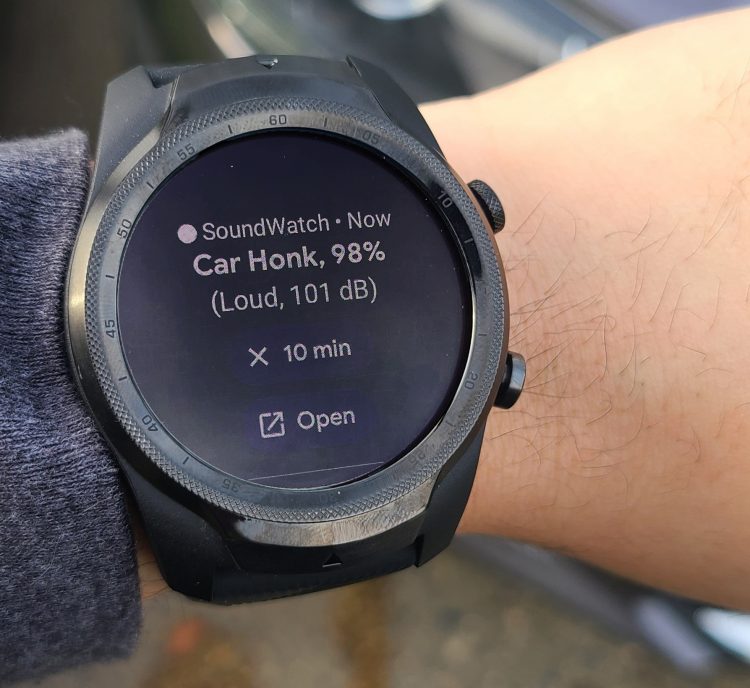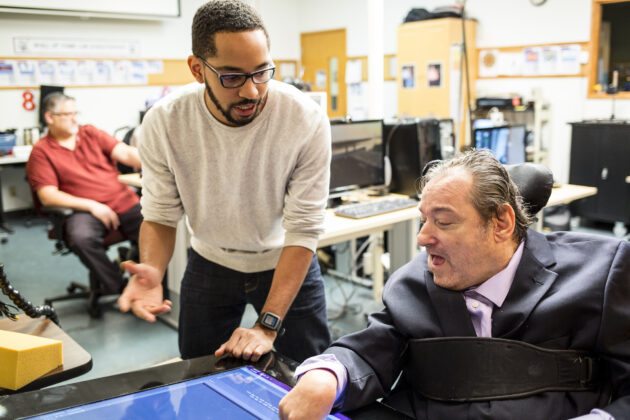Congratulations to UW CREATE faculty on multiple awards at ASSETS 2020, the International ACM SIGACCESS Conference on Computers and Accessibility! “The University of Washington has been a leader in accessible technology research, design, engineering, and evaluation for years. This latest round of awards from ACM ASSETS is further testament to the great work being done at the UW. Now, with the recent launch of CREATE, our award-winning faculty and students are brought together like never before, and we are already…
Author: Liz Diether-Martin
SoundWatch smartwatch app alerts d/Deaf and hard-of-hearing users to sounds

October 28, 2020 | UW News UW CREATE faculty members Jon Froehlich and Leah Findlater have helped develop a smartwatch app for d/Deaf and hard-of-hearing people who want to be aware of nearby sounds. The smartwatch will identify sounds the user is interested in — such as a siren, a water faucet left on, or a bird chirping — and send the user a friendly buzz along with information. “This technology provides people with a way to experience sounds that…
Feldner team receives grant to study pediatric mobility technology
October 20, 2020 The team, one of only three selected across the country, includes Sam Logan, an associate professor at Oregon State University, and Lisa Kenyon, a professor at Grand Valley State University. Study Details: The use of powered mobility devices for young children with cerebral palsy (CP) has been gaining traction. Evidence shows that the use of powered mobility at young ages complements (rather than detracts from) other interventions focused on more traditionally viewed mobility skills such as crawling…
NIH Rehabilitation Research 2020
October 13, 2020 Dr. Kat M. Steele, an associate director of CREATE, presents at NIH’s Rehabilitation Research 2020: Envisioning a Functional Future conference on Friday, October 16, 2020. She will be presenting in the Mobility Across the Lifespan session with Bernadette Gillick, PhD, PT from the University of Minnesota and Levi Hargrove from the Shirley Ryan AbilityLab. This meeting highlights rehabilitation research and informs the congressionally-mandated NIH Research Plan on Rehabilitation Research to inform priorities for the next four years….
UW CREATE leadership at ASSETS 2020
UW CREATE has a large and quality presence at ASSETS 2020, the premier annual conference for accessible computing research. Drawing from three departments, University of Washington authors contributed to six papers and two posters to be presented at this year’s online conference. Three of our papers were nominated for best paper! Seven members also served in conference roles: two on the organizing committee and five on the program committee. The papers and posters span a variety of topics including input…
Black Disability Art History 101: From Back in the Day to Today
The Inclusion Project, a youth led project, with the Center for Disability Leadership is hosting this workshop led by Leroy F. Moore Jr., founder of Krip-Hop Nation. Wed, October 21, 20203:30 – 5:00 p.m. PDT Learn more and register to attend Black disabled and Deaf artists have always existed. They were on the street corners down South singing the Blues, spray painting on New York subways, and bringing sign language to the big screen. Today, young Black disabled artists are…
Sara Hendren – What Can a Body Do?
October 6, 2020 The CREATE Conversation Hub hosts a live Q&A with Sara Hendren on the future of mobility and lessons she learned through writing her new book, What Can A Body Do? How We Meet the Built World. Sara Hendren: Future visions of mobility and lessons learned through writing What Can A Body Do? How We Meet the Built World January 8, 2021 at 11 a.m. Pacific time (2 p.m. Eastern time) Sara Hendren is an artist, design researcher, writer,…
Reimagining Mobility: CREATE Conversation Hub
What constitutes mobility and who gets to define it? How do we move and explore the world? What barriers and assumptions limit mobility? How do we support all forms of mobility throughout the lifespan? Mobility is about more than how we get from Point A to Point B. Regardless of form, mobility is a medium through which we interact and engage with the world. Yet, assumptions about “normal” or “acceptable” ways to move are literally cemented into our world.
Advancement of women with disabilities in STEM careers gets $1 million NSF award
The CREATE team applauds and congratulates AccessADVANCE, a new project that was recently awarded $1 million by the National Science Foundation. AccessADVANCE seeks to increase the participation and advancement of women with disabilities in academic science, technology, engineering, and math (STEM) careers. There are relatively few women who currently hold faculty positions in STEM fields and even fewer with disabilities. This effort has the potential to impact both — women in general, because any faculty member may at some point become disabled,…
Accessibility Do’s and Don’ts
For those designing anything, gov.uk has published best design practices for making services accessible in the form of six posters.
Richard Ladner Receives 2020 Public Service Award from National Science Board
National Science Board | August 11, 2020 Dr. Richard Ladner, CREATE’s Director for Education, has been named the 2020 recipient of the Public Service Award for an individual from the National Science Board (NSB). In recognizing Ladner, the board cited his exemplary science communication, diversity advocacy, and well-earned reputation as the “conscience of computing.” “When we think about diversity, we must include disability as part of that. The conversation about diversity should always include disability.” Richard Ladner, Professor Emeritus, University of Washington’s Paul G. Allen School of Computer Science & Engineering From…
Elks National Foundation Scholarship: deadline Nov. 2
Full-time UW students who have a deceased or disabled parent can apply for a $500 scholarship.
Participants Needed for Usability Study
Individuals with mobility impairments who use a wheelchair as their primary mobility device may qualify to participate in a paid usability study. Participants will test new technology that can improve workplace accessibility in an e-commerce fulfillment environment. The study will be conducted by Fieldwork, a national market research firm, on behalf of Amazon. Participants must be able to independently transfer to another surface, have good upper extremity function, be able to perform moderate levels of activity, and be able to…
AccessComputing shares UW CREATE’s launch and work toward accessibility
CREATE faculty are already internationally recognized for their contributions to assistive technology and accessible computing; by bringing them together under one organizational roof, CREATE will enable synergies and foster collaborations that enable faculty and students to become more than the sum of their parts.
Can Project Sidewalk Use Crowdsourcing to Help Seattleites Get Around?
July 23, 2019 | SeattleMet With the goal of making navigating our streets safer and easier for the mobility impaired, Jon Froehlich’s Project Sidewalk turns mapping sidewalks and improving pedestrian accessibility into a virtual game. To complete missions, users “walk” through city streets via Google Street View, labeling and rating the quality of sidewalks and features that make it easier—or tougher—to get around. They identify curb ramps, or lack thereof, assess their positioning, and point out tripping hazards. Since Froehlich…
Forbes’ Mindset Matters highlights CREATE as the innovation industry needs
Jonathan Kaufman, in Forbes magazine’s Mindset Matters column, calls for innovation to make workplaces inclusive and accessible. In his May 31, 2020 column, An Object Lesson For Business, And Innovation In The Age Of A Pandemic, he highlights the partnership between CREATE and Microsoft as a prime example of how we can “redefine the very nature of work and develop the tools needed to create a culture of innovation.” “It is at this moment that offers organizational leadership a means…
Q&A with Jacob Wobbrock on UW’S new accessible technology research center

iSchool news, University of Washington | May 28, 2020 Jacob O. Wobbrock, CREATE Co-Director and a professor in the UW Information School, has become one of the world’s foremost experts on accessible computing and human-computer interaction. His approach is to create interactive systems that can capitalize on the situated abilities of users, whatever they are, rather than make users contort themselves to become amenable to the ability-assumptions of rigid technologies. He calls this perspective Ability-Based Design. In the iSchool article, Wobbrock…
New UW center bankrolled by Microsoft aims to make technology more accessible to disabled people
The Seattle Times | May 28, 2020 University of Washington professor Jacob Wobbrock figures the best way to make technology more accessible to disabled people is to anticipate their needs from the very beginning. “The world we live in is built on certain assumptions,’’ Wobbrock said. “If we question those assumptions right from the start when we design things, then suddenly things are accessible.’’ The Center for Research and Education on Accessible Technology and Experience (CREATE) is launching with a nine-member,…
Microsoft invests $2.5M in CREATE, a new center for accessible tech at the University of Washington

GeekWire | May 28, 2020 Microsoft and the UW have long been aligned in a shared commitment to accessible technology and a world that is more accessible through technology. With a leadership team from six campus departments in three different colleges, CREATE will build upon the UW’s existing work in education, research and translation. Read the full GeekWire article.
UW launches new Center for Research and Education on Accessible Technology and Experiences with $2.5 million investment from Microsoft

UW News | May 28, 2020 The University of Washington today announced the establishment of the Center for Research and Education on Accessible Technology and Experiences (CREATE). Fueled by a $2.5 million inaugural investment from Microsoft, UW CREATE is led by an interdisciplinary team whose mission is to make technology accessible and to make the world accessible through technology. The center will build upon current projects in prioritizing and automating personalization, transitioning transportation to be accessible; augmenting abilities through wearable technologies; developing inclusive,…